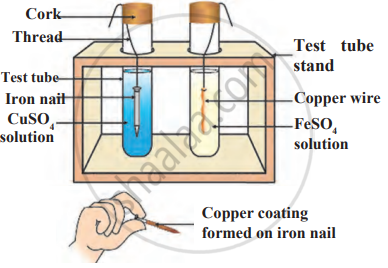Advertisements
Advertisements
प्रश्न
Divide the metals Cu, Zn, Ca, Mg, Fe, Na, Li into three groups, namely reactive metals, moderately reactive metals and less reactive metals.
उत्तर
| Reactive metals | Moderately reactive metals | Less reactive metals |
| Ca | Fe | Cu |
| Na | Zn | |
| Li | Mg |
APPEARS IN
संबंधित प्रश्न
Give one example each of which illustrates the following characteristics of a chemical reaction:
evolution of a gas
What do you observe when dilute sulphuric acid is added to granulated zinc?
What do you observe when silver nitrate is added to a solution of sodium chloride?
How will you obtain Silver chloride from silver nitrate.
Also give balanced equations for the reactions
What is meant by the metal reactivity series ? State its importance, (any two points).
Write chemical equation for the event.
Iron filings are dropped in aqueous solution of copper sulphate.
State what is meant by the ‘reactivity series of metals’
With reference to Acid explain with a suitable example of how the reactivity of the metals could be differentiated.
Select the correct answer for the statement given below:
The catalyst used in the catalytic reaction involving the reactants nitrogen and hydrogen.
Observe the following diagram and identify the type of reaction and write observation.

A metal A, which is used in thermite process, when heated with oxygen gives an oxide B, which is amphoteric in nature. Identify A and B. Write down the reactions of oxide B with HCl and NaOH.
A metal that exists as a liquid at room temperature is obtained by heating its sulphide in the presence of air. Identify the metal and its ore and give the reaction involved.
A metal M does not liberate hydrogen from acids but reacts with oxygen to give a black colour product. Identify M and black coloured product and also explain the reaction of M with oxygen.
Give the steps involved in the extraction of metals of low and medium reactivity from their respective sulphide ores.
Explain the following
- Reactivity of Al decreases if it is dipped in HNO3
- Carbon cannot reduce the oxides of Na or Mg
- NaCl is not a conductor of electricity in solid state whereas it does conduct electricity in aqueous solution as well as in molten state
- Iron articles are galvanised.
- Metals like Na, K, Ca and Mg are never found in their free state in nature.
An element A burns with golden flame in air. It reacts with another element B, atomic number 17 to give a product C. An aqueous solution of product C on electrolysis gives a compound D and liberates hydrogen. Identify A, B, C and D. Also write down the equations for the reactions involved.
Metal ‘A’ has electronic configuration 2, 8, 1 and metal ‘B’ has electronic configuration 2, 8, 8, 2. Out of these, which metal is more reactive? Write the reaction of this metal with dilute HCl acid.
Arrange the following as per the instruction given in the bracket:
Al, K, Mg, Ca (decreasing order of its reactivity)
